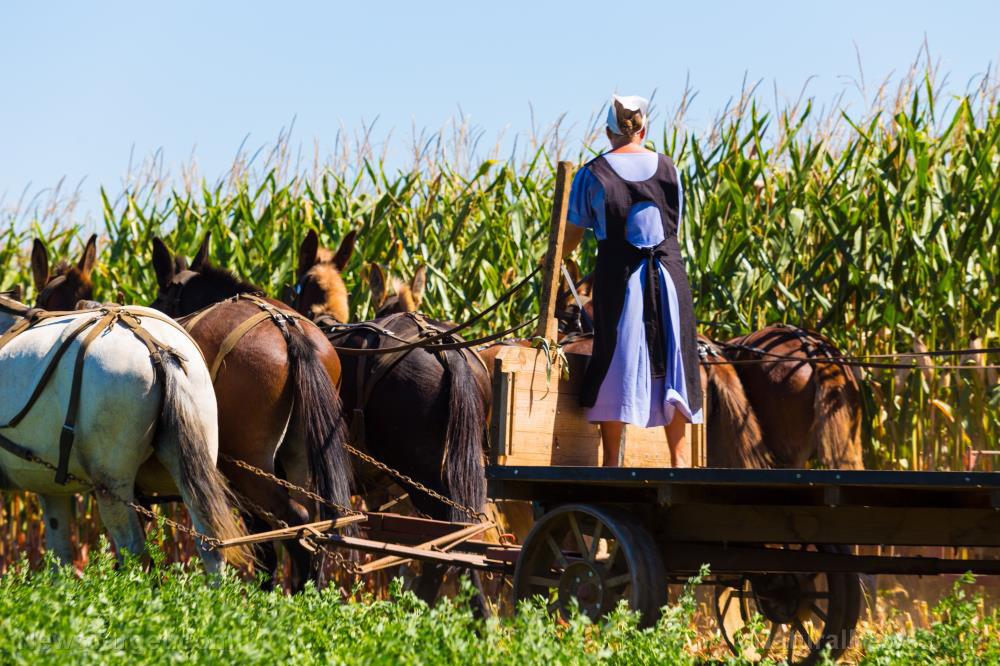
The Amish community can teach preppers many things about being self-sufficient and living independently off the grid.
Read on to learn how some Amish ways of living can be applied to the typical prepper lifestyle. (h/t to PreppersWill.com)
Housing
The Amish keep the cost of the house and outbuilding down by working with their community. A family's relatives and friends will often camp on the family's land to help build the new structure.
When the Amish are building a house, they build the structure, insulate it well and raise it on a site that takes full advantage of the sun and prevailing winds.
Cooling and heating
Cooling and heating costs are some of the biggest expenses of many modern American families.
This is how the Amish save money and stay cool during summer:
- Most Amish homes are built with a lot of windows to help circulate the air and bring in cooler overnight temperatures. The windows on the top floors are kept open to help the heat escape and the family stays on the lower floors within their homes for comfort.
- In some Amish homes, families used the basement as a gathering place for dining or playing games.
- Many Amish houses have a summer kitchen, which is a space connected to or near their house designed for cooking, smoking, pickling or canning during summer. The main purpose of the summer kitchen is to keep the heat and smell of cooking out of your main living quarters.
The Amish are born and raised without air conditioning and this has helped them become more tolerant of spending time in the summer heat. Many Amish families often wake up early to complete their chores before the sun comes up to avoid the sweltering heat.
After finishing their chores on hot days, the Amish sometimes take part in summer activities like swimming in nearby ponds or creeks or relaxing under a big tree with friends or books to stay cool even without electricity.
The Amish keep their homes warm with kerosene heaters, which work like large kerosene lamps.
A wick made of fiberglass and cotton integrates into a burner unit built above a tank filled with kerosene. The wick absorbs kerosene from the tank.
Other Amish homes have coal furnaces built into them. These furnaces need lumps of coal thrown into a fire pit to power them.
The coals stay fire-hot longer than wood and they are a practical space heater.
Wood stoves
Wood stoves can be used for both heating and cooking. While wood stoves are banned in some urban and semi-urban environments because they are considered heavy polluters and a fire hazard, many households still have them to help reduce their electricity and gas bills.
If the local laws allow it, do your research and purchase a quality wood stove and have it installed in your house. Alternatively, you can buy a second-hand one.
If you are planning on getting a wood stove, make sure you have easy access to a safe source of wood. Ideally, you should have a way to obtain the wood without having to pay for it to save on expenses.
Lighting
Modern homes come with electric lighting and it's one of the big components of newly built houses.
But if you build your off-grid homestead facing south, you can significantly reduce the need for electric lighting during the day with proper construction and a good alignment. You can also install light tubes or skylight kits that capture the light through a system of mirrors and help bring it inside the home. (Related: 5 Survival lessons we can learn from people who haven’t had power in their homes for hundreds of years.)
Another option is to use oil lamps. Some of these lamps provide light just as well as regular light bulbs. Some oil lamps are built with mirrors and glass, which provide better light dispersion than older lamps.
For mobility, use an oil lantern or get a rechargeable solar lamp or flashlight.
Food production
As a prepper, living off-grid means becoming self-sufficient and learning how to grow, find or process your own food.
If you are new to gardening, start by finding out which fruits and vegetables grow in your area. As you gain more experience, you will end up growing more in your garden food than you consume.
Preserve or sell the surplus of food to earn extra money for other preps. Aside from starting a home garden, you can produce food for your family by raising livestock.
Many food production tasks can also be accomplished with manual tools. While using electrical equipment is less work, if you want to live without electricity, you can survive with reliable manual tools.
Refrigeration
Before refrigeration was invented, people bought dried goods for storage. They also bought fresh produce at the farmer's market.
You can build a root cellar to store food and other perishable goods. If you want to preserve food, you can learn how to dry food or how to home-can fruits and vegetables.
Manual tools
Many electrical tools and appliances can make your life as a prepper easier, but there are manual alternatives to these tools so you can keep your homestead running even without electricity. These include tools like manual can openers and coffee grinders.
If you need to take care of chores inside or around the house, get manual drills, saws, rakes or brooms. You should also invest in manual tools that work just as well as electrical appliances and tools.
Electronics
If living without electricity is not an option, you can combine the Amish lifestyle and the conveniences of a modern home. For example, you can use manual tools and get a solar power system for important appliances, devices or tools that your family needs. You can also get a cell phone and charge it using a simple solar panel.
Look at how the Amish live if you want to learn how to survive on your homestead without electricity. If going completely off-grid isn't ideal for your situation, live a self-sufficient lifestyle on your homestead and use a generator or solar power system only when necessary.
Watch the video below to learn about the top six survival crops for your home garden.
This video is from the Deep South Homestead channel on Brighteon.com.
More related stories:
Survival essentials: 9 Off-grid appliances for your homestead.
10 Things that will still work after an electromagnetic pulse attack.
Emergency preparedness: 10 Ways to heat your home after SHTF.
Sources include:
Please contact us for more information.























